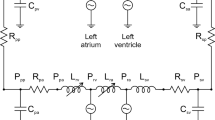Abstract
A method is presented in this paper for the in-vivo estimation of the nonlinear pressure-volume relationship of the human aorta. The method is based on nonlinear elastic reservoir theory and utilizes clinical data that can be obtained with a high degree of accuracy, namely stroke volume, end diastolic ventricular volume and aortic pressure trace data. The computational procedure is described and then carried out for six cardiac patients. A method for the estimation of instantaneous left ventricular volume during the ejection period based on the considered nonlinear elastic reservoir theory is also presented. The method is applied for the six cardiac patients cited and the results compared with those obtained for the same subjects by a method of estimation based on linear elastic reservoir theory described in a previous paper by the author (1969).
Similar content being viewed by others
Literature
Bader, Hermann. 1967. “Dependence of Wall Stress in the Human Thoracic Aorta on Age and Pressure”.Circulation Research,20, 354–361.
Conroy, M. F. 1969. “Estimation of Aortic Distensibility and Instantaneous Left Ventricular Volume in Living Man”.Bull. Math. Biophysics,31, 93–104.
Cope, F. W. 1960. “An Elastic Reservoir Theory of the Human Systemic Arterial System Using Current Data on Aortic Elasticity”.Bull. Math. Biophysics,22, 19–40.
Davila, Julio C. and Miguel E. Sanmarco. 1966. “An Analysis of the Fit of Mathematical Models Applicable to the Measurement of Left Ventricular Volume”.Am. J. Cardiology,18, 31–42.
Frank, Otto. 1899. “Die Grundform des Arterielle Pulses”.Z. f. Biol.,37, 483–526.
Hallock, P. and L. C. Benson. 1937. “Studies on the Elastic Properties of Human Isolated Aortas”.J. Clin. Invest.,16, 595–602.
Remington, J. W., C. R. Noback, W. F. Hamilton and J. J. Gold. 1948. “Volume Elasticity Characteristics of the Human Aorta and Prediction of the Stroke Volume from the Pressure Pulse”.Am. J. Physiol.,153, 298–308.
Simon, E. and W. W. Meyer. 1958. “Das Volumen, die Volumdehnbarkheit und die Druck-Längen-Beziehungen des gesamten aortalen Windkessels in Abhangigkeit von Alter, Hochdruck und Arterosklerose”.Klin. Wochschr.,36, 424–432.
Wagner, R. and E. Kapal. 1952 “Über die Eigenschaften des Aortenwindkessels”. 2. Mitteilung.Z. Biol.,105, 263–292.
Author information
Authors and Affiliations
Rights and permissions
About this article
Cite this article
Conroy, M.F. In-vivo estimations of the nonlinear pressure-volume relationship of the aorta and instantaneous left ventricular volume. Bulletin of Mathematical Biophysics 32, 155–172 (1970). https://doi.org/10.1007/BF02476882
Received:
Issue Date:
DOI: https://doi.org/10.1007/BF02476882




